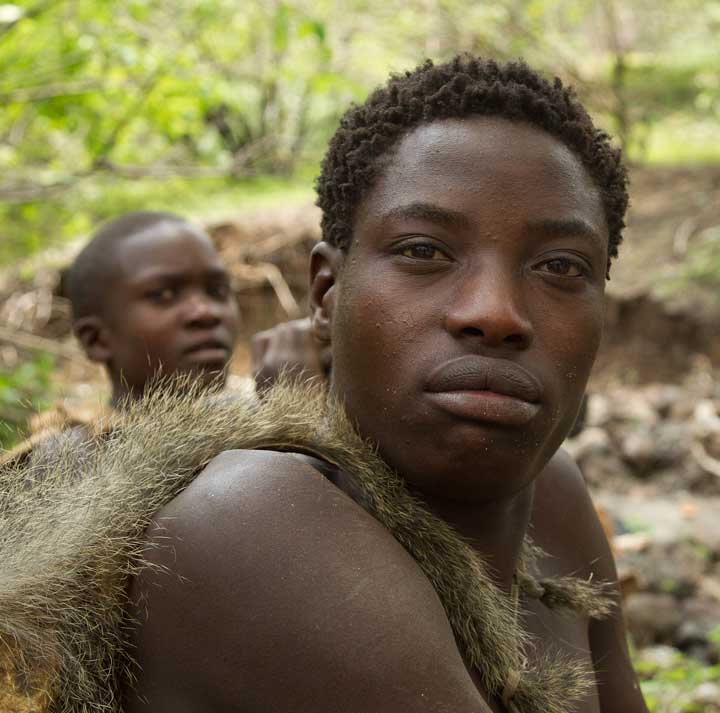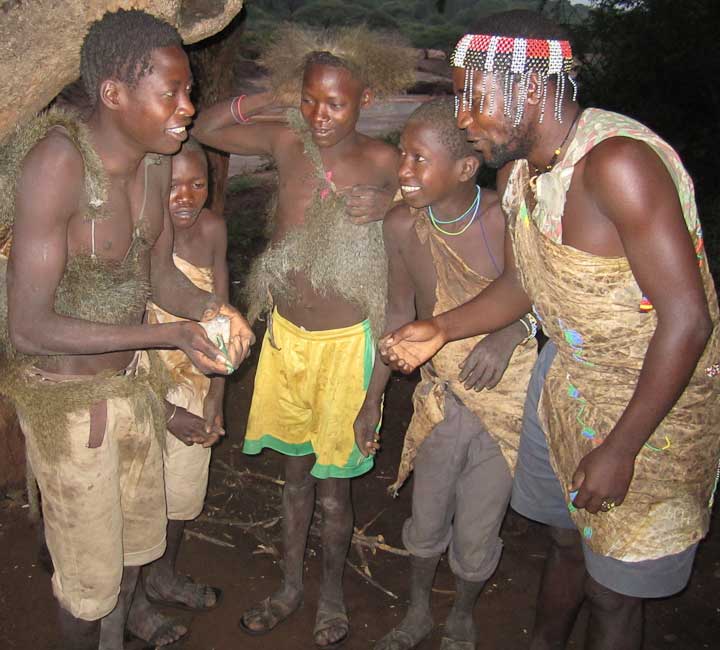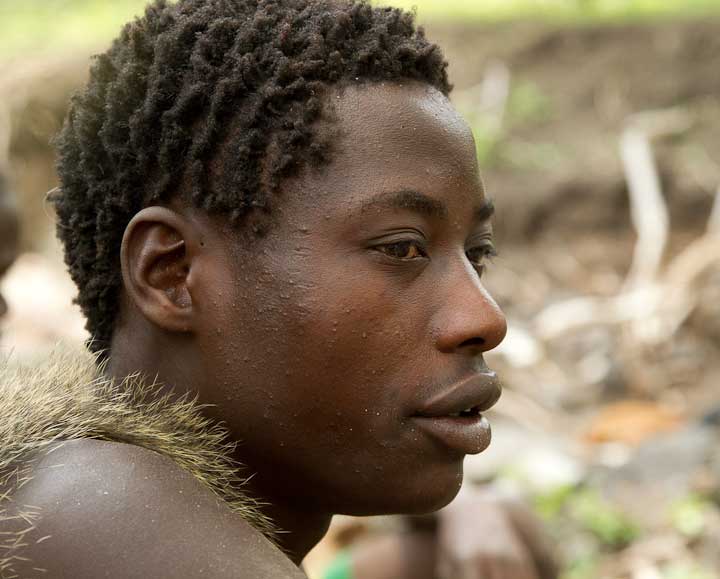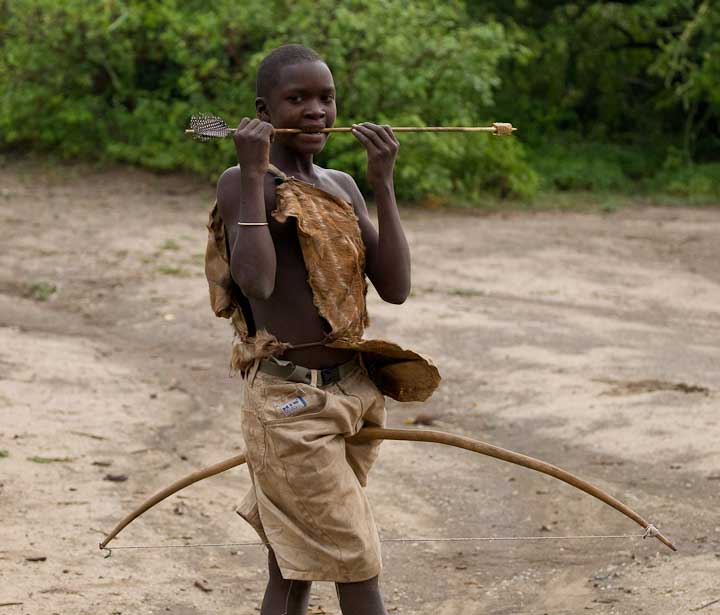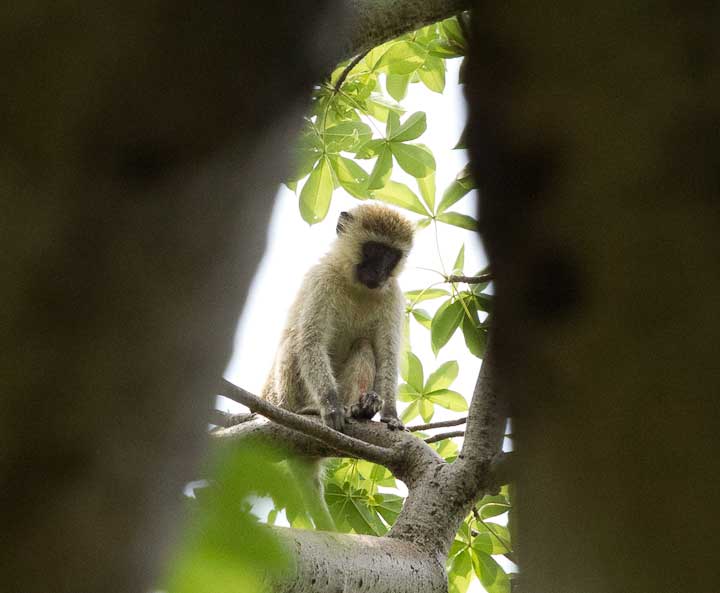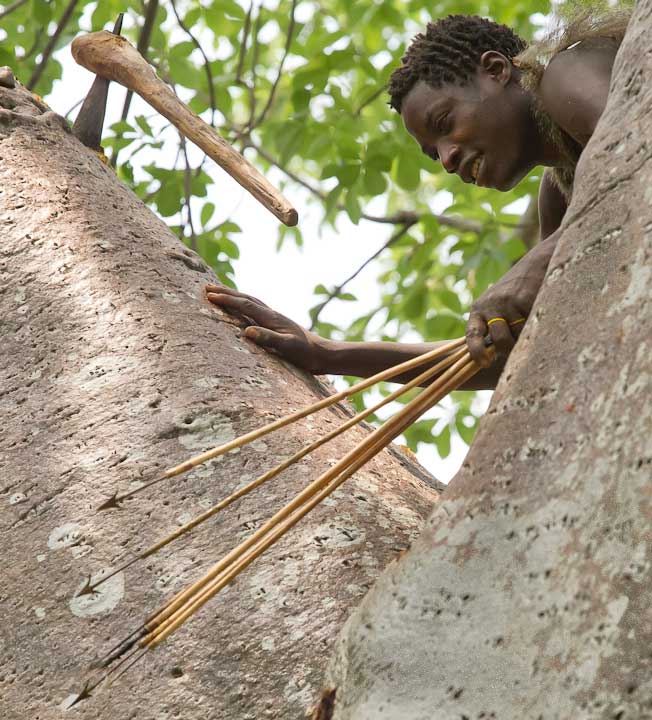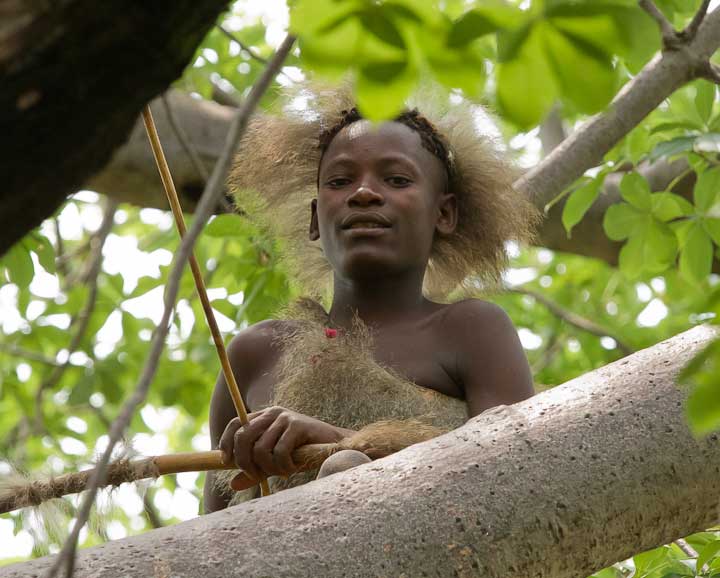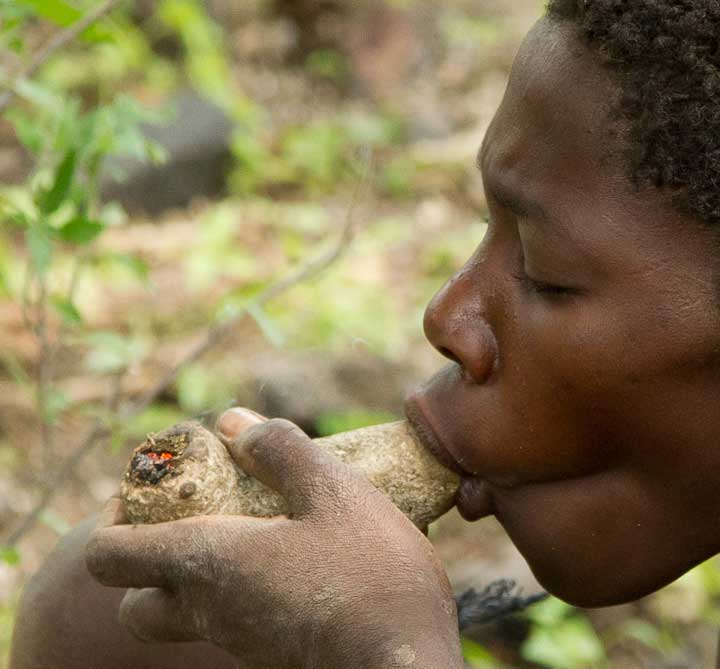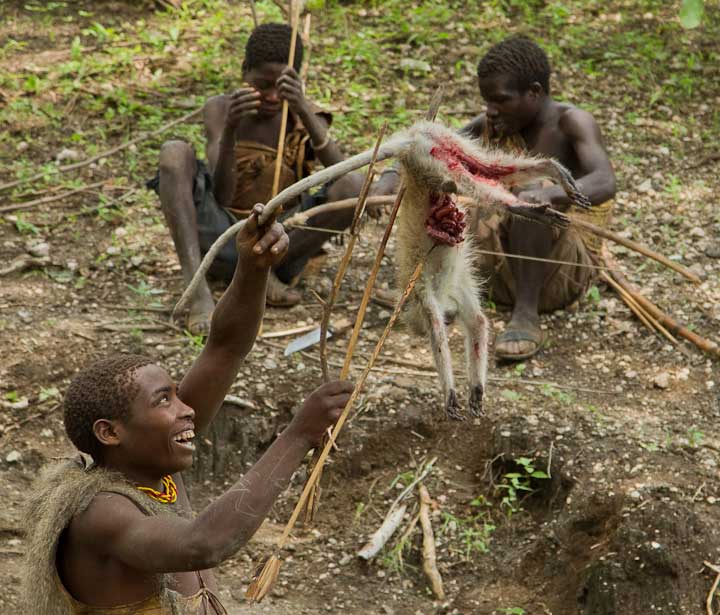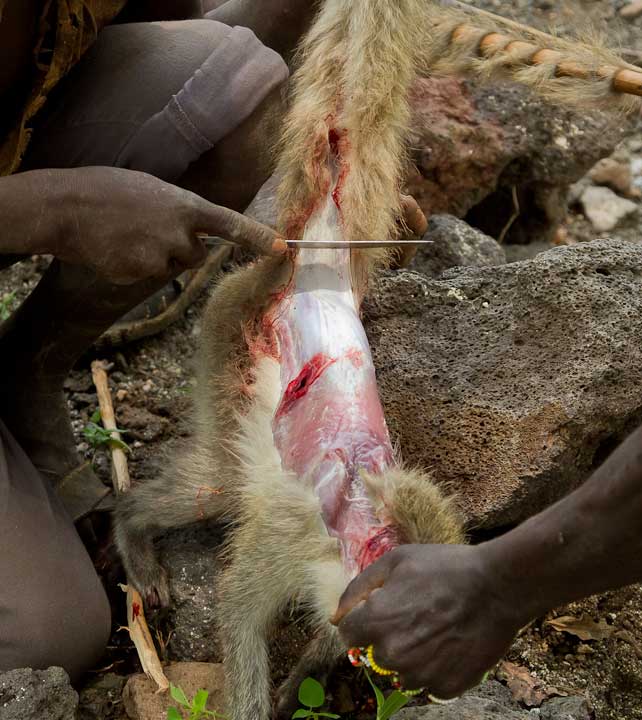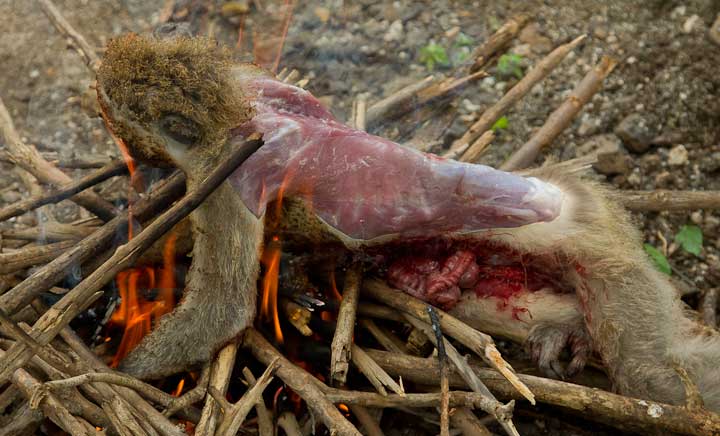People like the Hadzabe fascinate me, and when the guides on my 2009 safari told me they could set up this trip I jumped on the opportunity. Our guides told us that less than 1,000 tourists have been brought to see the Hadzabe in their daily routine. Our experience with them was genuine for the most part. Without the touristy part it would be difficult to see them so you have to accept this as a small part of the experience. Our group of 4, with our guide Firoz and an interpreter and Hadzabe guide named Hasani, spent part of 2 days with the Hadza as they went about their business. The culmination of our time with them was watching them hunt, which is showcased on this page.
His ancestors go back over 10,000 years, so you are in essence looking into the eyes of a caveman. It is hard to believe they even exist in this modern world. I wonder what he is thinking as he stares at me taking his photo.
The Hadzabe (also known as the Hadza) were on the cover of the December 2009 issue of National Geographic. I learned about them over 10 years earlier when my acquaintance James Stephenson literally lived with them for a year and wrote a book called “The Language of the Land: Living Among the Hadzabe in Africa”. I read the book before I went and also after I returned. Many of the places and descriptions of their behavior we were able to observe on our trip. It was fun to come back after the trip and read about something we actually observed!
This web page has a few of the pictures I took of our experience with the Hadzabe in February of 2011 when they went hunting. There is a 4 minute basic video at the end that is not to be missed because it complements the pictures. The National Geographic article and book referenced above will give you details about their unique lifestyle. To summarize- they live for the day and are exquisitely in tune with nature.
This map from the National Geographic article shows their territory near the Ngorongoro Crater. The dotted red lines show their range in the 1950’s, the solid red lines show their current reduced range. We saw them in the Mangola region. Agriculture and the pastoral lifestyle have encroached on their land, chasing their game away and shrinking their hunting grounds. Their population is down to 500 so their future as a society is at grave risk.
They use a click language like the bushmen of the Kalahari. This audio file is a Hadza speaking in his native tongue for a few seconds, with our guide Hazani interpreting it at the end. Listen carefully for the occasional click. Hasani will teach you how to speak like this if you visit them. Click here to download and watch the movie
We started early and met them as they were getting ready for their hunt. This Hadza is showing off a civet skin upon our arrival.
They are spiritual, surreal, and metaphysical all rolled into one mindset. Today they are rejoicing at the gift Hasani brought them- marijuana. Check out the baboon skins the two taller Hadza towards the left are wearing.
They use an ancient stone pipe and share their treat with everyone, including us if we wanted
to partake.They inhale deeply and cough up a storm. This potent version of marijuana puts
them in a different mindset as you will see from the following pictures and especially the video.
This Hadza (the same person that is staring at us at the beginning of this page) was the star of
the show, and even though he ranked below the older man above with the headdress, it was
his hunting skills that were the most impressive. He enjoyed his morning smoke also.
Now that he is properly ****faced he is ready to go hunting
Hasani is explaining the 3 different types of arrows they use:
1. The smaller one on the right for small game
2. The middle one for large game
3. The leftmost one with poison for dangerous game
The poison is made from a local cactus
Their bows and arrows are important tools, so time is spent inspecting for flaws before any hunt
It was a wet morning and their arrows were slightly warped due to the moisture. They straightened them by warming them up and using their teeth.
They also performed other repairs on their bows and arrows
A few more bites and its time to test the arrows. Notice how he holds his bow between his legs? We saw this again when they were hunting.
Time to go hunting. The dogs tag along, and get fed if the hunt is successful, but they do not aid the Hadza in the hunt
They are supremely in tune with their environment and will drink water we would not think of even bathing in. They can go long periods without drinking at all.
The intense look of a Hadza on the hunt for game. He uses all of his well developed senses to
detect game that we would not see or smell or hear. He heard a vervet monkey far ahead in
a tree and initiated a plan with the others to trap it in the tree.
After a short hike they spotted the monkey in a baobab tree. Instead of sneaking up on it
they made lots of noise to intimidate the monkey. This way it would go to the top of the tree it was already in, instead of fleeing to other trees.
The hapless monkey is doomed as they surround the tree and pelt it with their arrows
The bow string is made from animal tendon and is extremely taught
The doomed monkey with an arrow in its back foot. This is a great photo by Dominic at an elusive target.
Even though one arrow found its mark, the monkey is small, elusive, high in the tree, and well
hidden by the leaves. The main hunter in the group climbed the baobab tree for a better shot.
He pounds wooden spikes as footholds
It was strenuous work and he took a short break when he got 25 feet up Another hunter climbs to hand him his arrows and also assist him in shooting the monkey. I tried to remember not to stand below them for this shot when they passed the arrows, especially since one of the arrows is poisonous.
So, what do the others on the ground do while these two are shooting at the monkey from the
tree? They get stoned again of course!
That must have been some good stuff! He had poison arrows in his hand so I kept my distance.
Even in this altered state of mind he keeps a wary eye on the monkey
The remainder of this page contains graphic pictures of a monkey being cooked and eaten that are not suitable for all viewers Eventually the hunters in the tree hit the monkey with 2 more arrows, one in the abdomen and one in the flank. The monkey fell to the ground a short time later and one of the Hadza jubilantly holds it up for all to see.
The Hadza cook their meal on the spot so they start a fire with sticks using only friction.
The monkey is skinned with a knife from the head Hadza
The partially skinned monkey is just tossed on the fire for about 20 minutes, being turned several times
No part goes to waste. The intestines are given to the dogs. I tried a small piece from the cheek. And yes, it tastes the way it is supposed to- like chicken!
Everyone shares in the feast. It is amazing how such a little monkey can feed this group, with
leftovers to bring back home. They eat very little, and coupled with their extremely active lifestyle, stay lean and strong.
The elderly member of the group gets the brain at the end. It is obvious he savors every bite.
This is what cooked monkey brain looks like up close
What remains is wrapped in leaves and brought back to their primitive camp
This 4 minute basic video shows the above pictures in action.
Our group of Hadzabe observers!


